Phoenix from the flames, part 1: Veritas
Author
Date
- March 15, 2002
Related articles
- Early post-war German F2, F Libre and sports cars - Phoenix from the flames, by 'Uechtel'
- Introduction
- Part 2: AFM
- Part 3: The smaller marques
- Part 4: West German BMW specials
- Part 5: Foreign appearances and guest drives
- Part 6: East German BMW specials
- Part 7: EMW/DAMW
- AFM - Alex von Falkenhausen's brave F2 effort, by Mattijs Diepraam
- Early post-war German F2 cars - The BMW-derived specials that appeared in war-struck Germany, by Mattijs Diepraam
- Veritas - Self-made German privateers to the fore, by Mattijs Diepraam
Who?Paul Pietsch, Willy Daetwyler, Toni Ulmen What?Veritas Meteor, Veritas Meteor (entered by Ecurie Suisse), Veritas RS Where?Nürburgring When?1951 Eifelrennen (3 June 1951) |
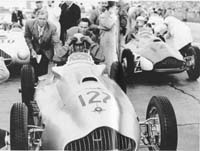 |
Why?
This story will tell how it came to be that former Maserati star driver Paul Pietsch made the best of his final chance for a Nürburgring win in 1951, thereby also making somewhat like a compensation for the shock he gave the German crowd with his Maserati performance here in 1939 by finally fulfilling the high expectations they had put onto this car. And it tells how it happened that significantly so much attention was paid to the two single-seaters in the picture while the almost completely neglected third car in the background would have deserved it so much more, as with its 42 race victories this type was the real winner in that marque's production line and the mainstay of German early post-war racing altogether. So here is the story of Veritas!
This history will unfold picture by picture. I think the best way to tell is to concentrate on one marque after the other, beginning with the most important first, Veritas.
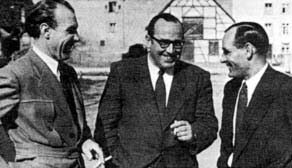
The three men behind the Veritas Marque: Georg "Schorsch" Meier, Lorenz Dietrich and Ernst Loof
Veritas can be regarded as perhaps the only professional German effort in premier-level post-war racing, despite – of course – never reaching a true manufacturer's status. But no other German marque came close to that company's programme of a serial production of about 10 Formula 2 single-seaters and over 30 highly competitive sports cars. In addition to this Veritas was also the only German company of some recognizable international presence and reputation and in that period.
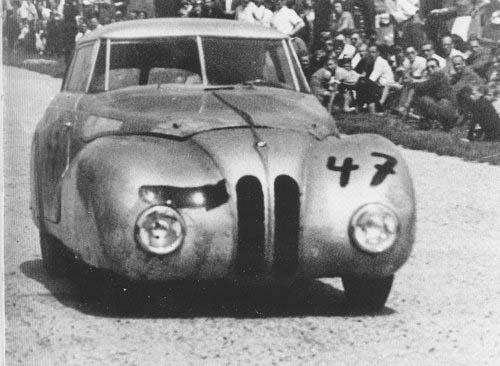
Karl Kling in Ernst Loof's BMW 328 Mille Miglia Limousine at Hockenheim in 1947, winner in the 2-litre sports car class
1947, Pt. I
The central figure behind the Veritas company was Ernst Loof, who had been member of the BMW race department and later chief of the styling department pre-war, responsible for the famous BMW 328 Mille Miglia design.
Shortly after the war Loof grabbed the occasion and bought the former BMW Mille Miglia Streamliner. In this car Hermann Lang won the very first post-war race in Germany, the Ruhestein hillclimb of 1946. The picture shows the car when driven by Karl Kling at the 1947 race at Hockenheim. At that time Loof lived from collecting wrecked BMW 328s and building new cars out of their parts. He also experimented with a streamlined car based on the BMW 328, very similar to Mille Miglia Roadsters. This car can be regarded as the prototype of the Veritas RS series, and Loof intended to build up a serial production of this model.
His partners were two friends of him, Lorenz Dietrich, a former BMW director, and Georg "Schorsch" Meier, the ex-motorbike champion, who had also had some Grand Prix starts for Mercedes and Auto Union before the war. Later they were joined later by Werner Miethe, a former bicycle racer. Initially Hermann Holbein had belonged to this group, too, but things did not develop the way he wanted and so he departed and built his own cars (see the Holbein chapter).
At that time Germany was still under allied rule and only in the French occupation zone the officals allowed Loof to establish car production. Dietrich, who had some good connections in France, named the company after the French company Bureau Veritas, which was well-known for classifying ships. The French authorities granted them an old mill at Hausen near Messkirch (area of Baden, Southwest Germany), where the new company took up business in March 1947. As expected their designs were initially based on the very successful pre-war BMW 328, which remained the backbone of German motorsport activities well into the fifties.
There is some discrepancy in my sources, as some tell that the first factory-built Veritas was not completed before 1948, others say that the first such car was raced by Kling already at the Eggberg hillclimb in the summer of 1947. But perhaps this was the already mentioned prototype, built before the foundation of the company.
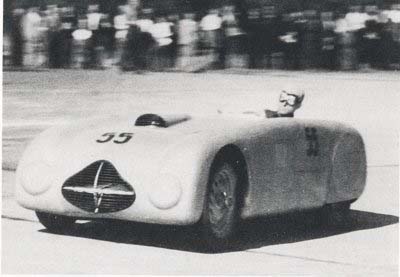
Karl Kling in his self-built Veritas RS during practise for the sports car race at Hamburg.
1947, Pt. II
The most logical way to start telling the story of Veritas is of course to begin with the oldest picture. It shows Karl Kling during practise for the Stadtparkrennen at Hamburg, 31 August 1947. Like most of the cars of this era this one has a very individual story, too, and - if this information is right - a purist could remark, that this is no true Veritas at all, as the car was not even produced by the "factory", but as a private effort of Kling himself. So it is saved from being regarded rather as an home-built Eigenbau only by the fact that it was built accordingly to the original Veritas plans!
Karl Kling had been a long-time friend of Loof and so he could watch the first Veritas sports cars nearing completion. Keen to get his hands on such a car he simply was not wealthy enough to buy one. So he persuaded Loof to hand him out the construction plans in order to build up one by himself, which he carried out at Stuttgart in the garage of Richard Bez.
The car was just ready in time for the Stadtparkrennen, where Kling set best practice time right from the start. But being somewhat overambitious he tried to go even faster, overdid things and crashed, damaging the car beyond immediate repair, so that he could not take part in the race. So after the retirement of Polensky's new "Kurpfalz" sports car the race was won by Ulmen from Schäufele and Krakau, all on BMW 328.
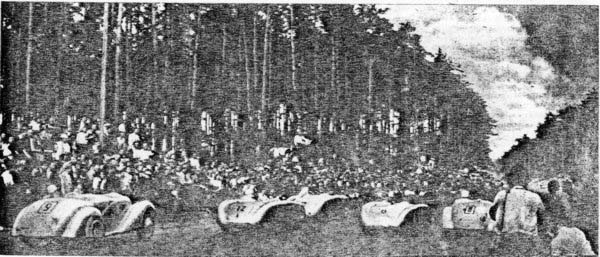
The start of the 2-litre sports car class at Hockenheim in 1948. Three of the new Veritas RS making the offical debut for that make. No.2 is Karl Kling, No.6 Toni Ulmen and No.12 is Ralph Roese, while cars No.8 and 9 are standard BMW 328.
1948, Pt. I
During the winter of 1947-'48 Loof and his company had been very busy. Production was moved to new premises at Messkirch and as the result no fewer than four brand-new Veritas sports cars (plus Kling's repaired one) appeared at Hockenheim for the season opener!
The new Veritas RS was based on a very light combined tube section/spaceframe chassis of only 36kg, covered by all-enveloping streamlined bodywork (which gave the car its "bathtub" nickname) and fitted with standard BMW 328 suspensions. This was ready to accept the approved BMW 328 engine, which was available either in 2 or 1.5-litre form.
With this design Veritas was really a pioneer in German post-war racing in a time when most of the opposition still had to rely either on outdated pre-war machinery or home-built specials. So the German public was very excited to see their debut at Hockenheim and the high expectations were to be fulfilled.
Indeed Glöckler managed only a third place in the 1500 cc sports car class, but at the start of the 2-litre race there were no less than three Veritases. Kling and Ralph Roese totally dominated the race, while Ulmen dropped out. Alas, there is only this very poor picture of this historic event in my archive, copied from a copy of an old issue of Das Auto.
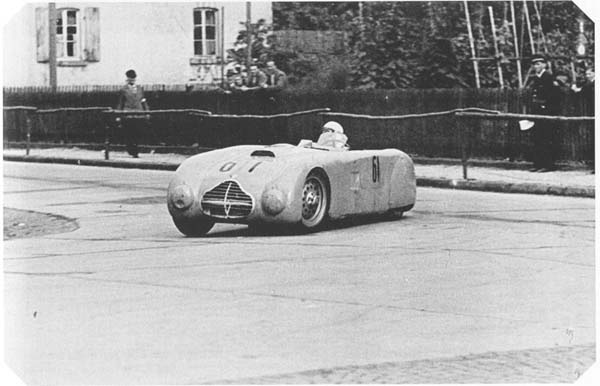
Georg Meier in the special-engine Veritas RS at the Schottenring in 1948.
1948, Pt. II
But there was still one more object of public interest at Hockenheim. The big surprise of the weekend was yet another of the Veritas RS, turning up in the race car class. The car featured a very special BMW engine with three camshafts (!), named to deliver 140hp, which should later be installed in the already announced Veritas Monoposto. As an indication to the company's determination to enter single seater racing this was regarded as a test run. The race was not only run to the new Fomrula 2 rules, but open to Formule Libre cars, and so it was quite a sensation when Meier won against the opposition of much more powerful supercharged cars.
Inspired by this Meier started several times this year, but to his and Loof's annoyment the car proved to be generally slower than Kling's sports car with the conventional engine. Above Meier can be seen at the Schottenring, where he finished second overall, winning the Formula 2 class of the race.
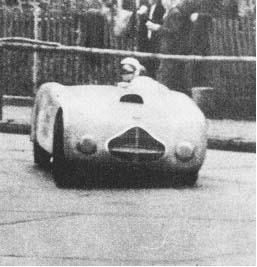
Karl Kling in his Veritas RS at the Schottenring. He won the 2-litre sports car class in 1948.
1948, Pt. III
It is obvious that Kling's home-built car received much better preparation than the works cars, for he totally dominated the sports car races of the season. His success at Hockenheim was followed by wins at Cologne, Karlsruhe, the Schottenring and also at the Eggberg hillclimb. With these results he was of course also awarded with the title of German champion. This picture shows him at the very demanding Schottenring, which was regarded to be of similar character to the Nürburgring.
At this point another remark on Veritas: Seated in the French occupation zone in Germany the company had always good connections to France. Perhaps this was the reason why two of their cars turned up at the 1948 Coupe des Petits Cylindrées at Reims at a time when German cars and drivers were still banned from the international scene until 1950. And here seems to be a cause for later confusion among the historians, as the cars of Chaboud and Loyer were entered as "Meteors", perhaps simply to avoid the name of the German marque. But nevertheless these cars were standard Veritas RS sports models (Chaboud is reported to have borrowed Kling's car), which had nothing in common with the later series of Veritas Meteor Formula 2 cars.
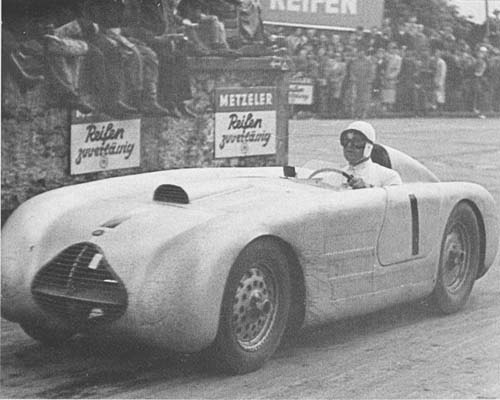
Karl Kling repeating his Schottenring victory in 1949 in his new Veritas RS.
1949, Pt I
Kling, who had built a new car by himself at the end of the previous season, again dominated the 2-litre sports car class in 1949. With victories at Hockenheim, Nürburgring, Schotten, Tübingen, the Schauinsland hillclimb, the Eifelrennen, at the Nürburgring again and at the Solitude he again overwhelmingly won the German championship. He was defeated only two times, by Roese at the high-speed Grenzlandring and by Ulmen at Cologne, both of course also on Veritas RS sports cars! The picture shows him during his successful drive at the Schottenring.
In the 1.5-litre class there was complete Veritas domination, too, and the title went to Helm Glöckler.
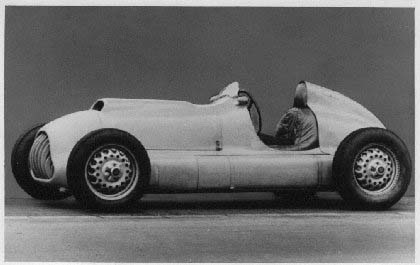
The Veritas Meteor prototype in its initial 1949 shape.
1949 Pt. II
Because of the impressive performances in the sports car categories the German public eagerly awaited the company's new Formula 2 monoposto to appear. But the completion of the model was delayed by the search for a suitable engine. When the car appeared briefly during the 1948 Eggberg hillclimb, intended to be driven by Heinrich Herbster, it was reported that its huge Bugatti 2.3-litre engine (which had been installed as a stop gap until a suitable Formula 2 engine was available) did not leave enough space in the cockpit for the driver's legs! It seems that this car was later fitted with either a BMW or perhaps an early Meteor engine and sold to American Alexander Orley, who raced it very frequently in Belgian and international events from 1949 onward. Again, as Veritas perhaps sounded too German, the car was entered under pseudonyms like Orley Special or even Todd Special. Alas, despite its many appearances I have not been able to find a single photo yet showing this car. This is really a pity, as such a picture would fill an important gap in my Veritas story.
As already mentioned, in addition to the disappointment with this prototype monoposto also the special triple-camshaft BMW engine turned out to be a flop when raced by Meier in 1948. This left nothing else for the company to do but to build their own engine. It was designed by Loof himself and the Heinkel factory at Stuttgart took over its serial production. So the Meteor engine, as it was christened, had nothing in common with the BMW 328, besides the fact that both engines were straight-sixes. The main difference was that the Veritas engine had a single overhead camshaft, thus avoiding the complex system of the BMW. With its three downdraught carburettors the engine was very tall, resulting in a comparatively high bonnet with central air-intake, which was also characteristical for the BMW-powered cars. The picture shows the very first Meteor in its initial 1949 shape.
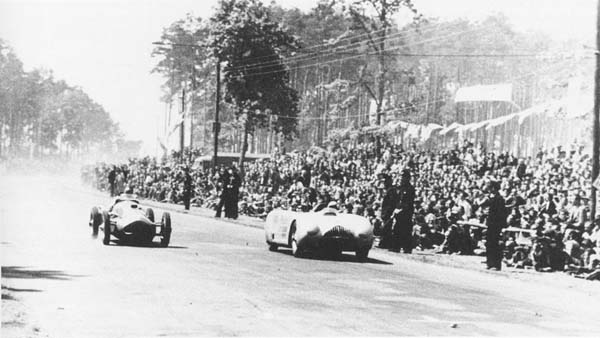
A close finish! Ulmen in the Veritas RS just snatches victory from von Falkenhausen's AFM with a margin of only 0.7 seconds. Hockenheim 1949.
1949, Pt. III
Of course the construction of the new Meteor engine meant further delay for the appearance of the Veritas single-seater, so drivers like Toni Ulmen had to use the company's conventional RS sports car as a stop gap for the Formula 2 races. But this turned out to be no real disadvantage for him, the car being reliable and very quick, especially on high-speed circuits like Hockenheim or the Grenzlandring. The picture shows him crossing the line in front of von Falkenhausen's AFM to win the season-opener at Hockenheim.
Ulmen later also won the races at Munich, Nürburgring, Grenzlandring, Solitude and Cologne to become German race car champion of 1949. So that year Veritas had won the titles in all three classes which they had built suitable cars for.
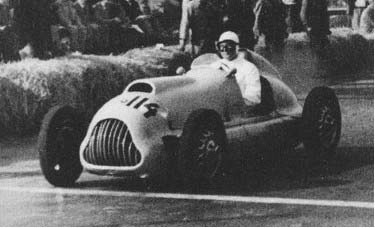
Karl Kling ready to give the new Veritas Meteor its debut at the start of the Cologne race in 1949.
1949, Pt. IV
At the end of 1949 the company's future could not have seemed brighter as in the meantime their new Formula 2 monoposto finally was completed, ready in time for the last race of the season at Cologne, where it was entrusted to the dominant driver of the early years, Karl Kling. The debut of the design was rather promising as Kling initially battled for the lead with Hans Stuck in the AFM. But then he spun and stalled, being push-started by some spectators, which finally lead to his disqualification. Stuck retired after leading the first seven laps, so victory again fell to Ulmen in his quick Veritas "Pontoon".
But there were also some shadows rising at the bright horizon. In the meantime the company had taken up serial production of a road-going version of the RS, at the time Germany's most powerful (and also most expensive) car. In addition to that a contract had been mad with the French Panhard concern for a licence production of the popular Dyna. Of course these various activities overstressed the small company's limited resources and it began to run into financial problems.
1950, Introduction
When finally the ban on German cars and drivers at foreign events was suspended at the beginning of 1950, new financial chances opened up on the international race car market, while the local German economy still was very poor after the war. In contrast to that, public opinion still connected German racing activities with Mercedes' and Auto Union's pre-war domination and the Veritas company was expected to continue this tradition after their successes in 1949. Consequently the company received quite a considerable number of orders for their new Meteor Formula 2 car. Peter Hirt, Paul Glauser and "J.M. Marcy", three wealthy customers from Switzerland (was Marcy a Belgian?) even tried to put up a Swiss team, ordering three Meteors, while some cars later also appeared in Belgium.
But instead of concentrating on the development and completion of his customer's cars, Loof, who by now was running the company on a rather hand-to-mouth-basis, spent their already paid money to build up the serial production of the road-going touring cars, for which the company changed its location one more time and moved to a factory at Muggensturm near Rastatt.
When his customers finally became unpatient, the cars were only hastily put together, severely lacking from finish and reliability. This had not been evident in the comparatively short German events, where most races were run over distances between 50 and 100km, but the deficits were soon to be uncovered when raced against international opposition. Of course this compromised the marque's reputation and as a consequence orders ran dry, which additionally increased the company's financial crisis. Finally Veritas went bankrupt in November and had to be closed down.
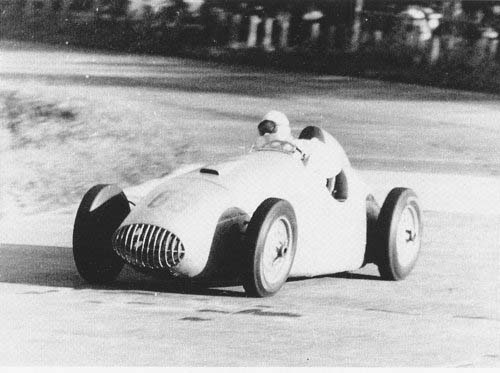
Toni Ulmen in his Veritas RS-based special on his way to become best German finisher in his 1950 home Grand Prix, 4th position at the end.
1950, Pt. I
But back to the 1950 racing season. Hirt and Glauser had received their cars the day before the race at Erlen in Switzerland. But the cars were not in race-ready condition and while Glauser had to retire after only a few laps in the race Hirt was not even able to take the start.
Instead another Veritas car showed what would have been possible if a car would be sufficiently prepared. In spite of winning the 1949 title on his pontoon shaped sports car Ulmen had already realized the disadvantages of the so called "Aerosaurian", as the car was called because of its unwieldy bodywork. So one of his RS sports cars received open-wheeled bodywork and was converted into a single-seater, while he retained also one of the streamliners for the high-speed events and the sports car races. With the open-wheeler Ulmen finished a surprising third in the race at Erlen, beaten only by the two Ferraris of Villoresi and Vallone, but in front of four Gordinis.
In the entry lists the car sometimes appears as "Veritas Spezial", sometimes even as a Meteor, but it must not be mismatched with the regular Veritas Formula 2 car, as Ulmen's car still had the BMW engine. In fact the identity of this car is still somewhat mysterious to me, as maybe it was the prototype car with the special engine, in which Meier raced the 1948 season before it was sold to Ulmen. If so then the car was later converted once again, this time into an open-wheeled two-seater, hence suitable for sports car races as well as for Formula 2 events. But there is also evidence that Ulmen owned a third car, which was used for that conversion. The above picture shows Ulmen's "Veritas Spezial" during the German Grand Prix later in the season.
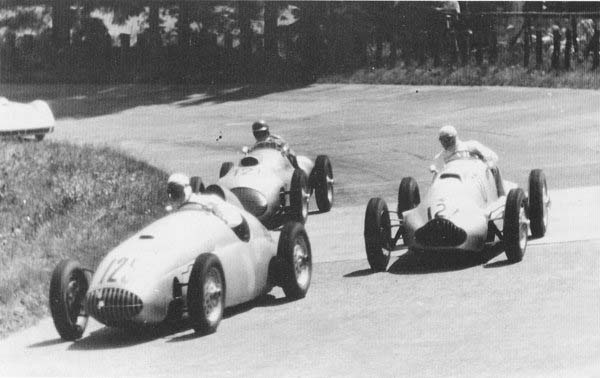
The battle for the lead in the early stages of the 1950 Eifelrennen between Ulmen (125), Ulmen-Veritas RS Spezial, Lang (127), Veritas Meteor, and Rieß (121), AFM 50-BMW, pursued by Kling in the Veritas Meteor Streamliner.
1950, Pt. II
At the Eifelrennen no fewer than four Veritas race cars took the start from a grid of seven, among them Ulmen's special (No. 125) and pre-war star driver Hermann Lang in the original Meteor (No. 127). The further two were Heinz-Gerd Jäger in a standard-bodied Veritas RS spors car and Karl Kling's streamlined Meteor version, which will be described later. (To compare them take a look at the grid picture in the chapter on AFM.) But in spite of the sheer majority in numbers the race was a true disaster for the Meteors again. While the picture suggests that there was quite a fierce battle for the lead between Ulmen, Lang and Rieß with Kling not far behind, Lang's car lasted only one lap before he had to retire with a leaky cylinder head, while Kling's car burnt a piston on lap three. In the end Rieß won from Ulmen and Gommann, an AFM 1-3 finish.
Afterwards there was deep annoyance among the German fans, as of course they had expected the Meteors to be a real challenger for all the Ferraris, Gordinis and HWMs at the forthcoming German Grand Prix. Their spirit eased up a only little bit when Kling won from Lang at the Solitudering, where this time the AFMs had run into problems.
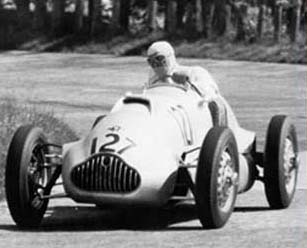
Hermann Lang's Veritas Meteor during the 1950 Eifelrennen.
This is another picture of Lang's Meteor, which is what I believe to be the rebodied prototype Kling had used at Cologne in 1949.
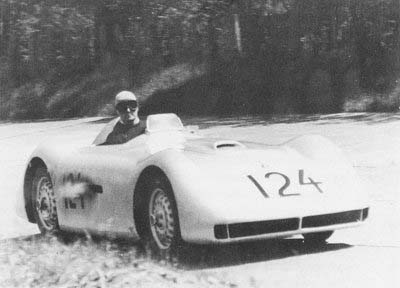
Karl Kling in his streamlined Veritas Meteor in the Eifelrennen of 1950.
Another interesting machine appearing at the Eifelrennen is the No.124 car with its streamlined bodywork. This is in fact the first Meteor customer car in Germany, ordered by Karl Kling. As usual, Kling was not content with a standard version, but ordered this special bodywork at the famous coachwork company Hebmüller. The car is often mismatched with the RS sports model, but the picture makes clear that this is a true monoposto with the driver's seat in the centreline of the car.
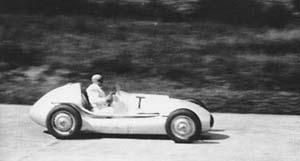
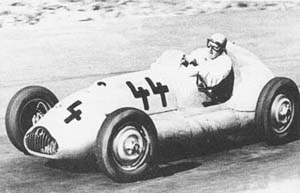
The brand-new Veritas Meteor of Paul Pietsch during practice (left) for the 1950 German Grand Prix and in the race (right).
1950, Pt III
For the local scene the German Grand Prix at the Nürburgring really was of course the highlight of the season. Consequently everybody who owned some sort of a race car tried to get into this event. In fact every existing Meteor appeared: in addition to Lang and Kling, also the full three-car team of Ecurie Suisse with Hirt, Glauser and "Marcy". They were backed by Ulmen in his single-seater and a collection of German specials. Further to that the Veritas "factory" had done its best to complete a sixth Meteor just in time for the race, driven by Paul Pietsch on what can be regarded as a semi-works entry. As can be seen on the first picture, the car arrived so late that Pietsch did not even get a starting number for practice! When he was finally officially allowed into the event he was given No.44.
But the race gave us the usual Meteor disaster. None of the six Meteors lasted to the finish line and in fact five of them had not even survived the first half of scheduled 16 laps. The race was dominated by Ascari in the Ferrari, followed by the two 1.5-litre Gordinis of Simon and Trintignant. Again Ulmen's special had turned out to be the best of the rest, as he finished in fourth place, a lap down. With this result on his scoreboard Ulmen also deservedly won the title of the 1950 German Champion on race cars.
The last race of the season at the ultra-fast Grenzlandring then again was won by Kling in the well-suited streamliner. It seems that this car showed much higher reliability, most probably due to the fact that Kling maintained the car by himself, while Lang in the quasi-works machine symptomatically had to retire from the start due to an engine failure.
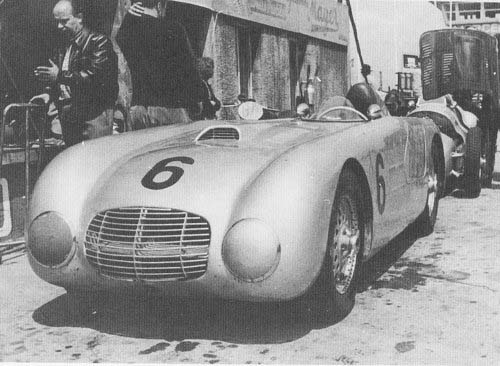
The Veritas RS of Rieß with its uniquely shaped radiator grille. The car in the back most probably is his AFM monoposto. Any idea "where"?
1950, Pt. IV
Meanwhile an interesting season of sports car racing had developed during 1950, too, with Veritas domination still unchallenged and all races in the 1.5 and 2-litre categories won by cars of this make.
While Pietsch won the title in the smaller class, Rieß became champion in the big class after his victories at the Eifelrennen, and the Schauinsland hillclimb, while he also scored full points at the Grand Prix as best placed German driver in that race, second behind the Gordini of Trintignant. Interestingly, it is reported that Rieß used that very car, which had been home-made by Kling in 1947, now with a slightly revised bodywork, which can be seen on the picture (but there is some evidence that this picture might be taken during the 1951 season). With its rather rectangular radiator grille Rieß' car is easy to recognize on the pictures among the other Veritases.
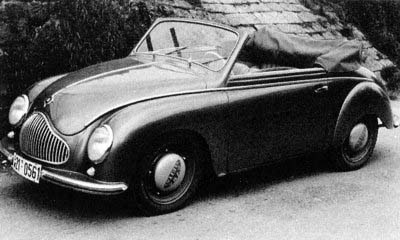
The Dyna-Veritas 750, 1951
1951, Pt. I
After the Veritas breakdown at the end of 1950 its former founders departed and Lorenz Dietrich moved to Baden-Baden. There he founded the Dyna company, intended to continue production of the neat little Dyna-Veritas, based on a Panhard license, which he could keep up on a rather limited scale for a few years.
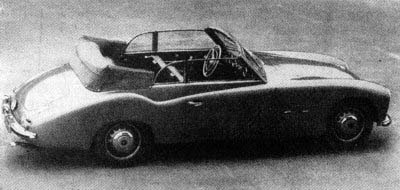
Veritas-Nürburgring 2 Liter Cabriolet, 1952.
1951, Pt. II
The indefatigable Loof, now completely on his own, still did not give up. He rented the former Auto Union pits at the Nürburgring in 1951, where he tried to continue serial production of his road-going sports and touring cars under the "Veritas-Nürburgring" marque. The cars were built around a domesticated, yet more reliable version of the Meteor engine (still produced at the Heinkel factory in Stuttgart), so the owners could really feel some kind of racing flair when driving their cars. But he only succeeded in completing some 20 cars during the next years, before the company had to be liquidated again.
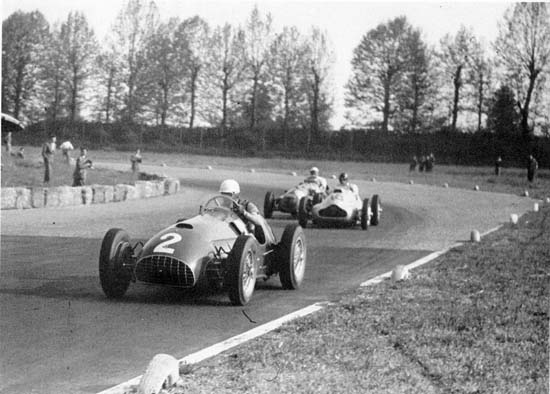
Paul Pietsch in close battle with Villoresi (Ferrari) and an HWM at Monza in 1951.
1951, Pt. III
Under these circumstances the Veritas company could of course only give some very limited support to its customers, who had to carry on mainly on their own. Certainly the main Veritas protagonist that season was Paul Pietsch. He also recorded the first foreign start of a German-owned Meteor, when he took part in the early season Monza Grand Prix. He qualified well for a mid-field grid position, but despite of the close-looking battle with Villoresi's Ferrari and an HWM on the picture, the car soon ran into the usual technical troubles and Pietsch had to struggle on at the tail of the field.
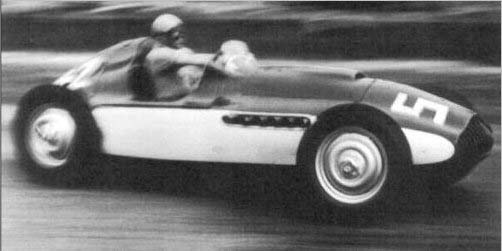
First Veritas in a World Championship event: Peter Hirt in his Scuderia Espadon Meteor 1951 at the Swiss Grand Prix.
1951, Pt. IV
In spite of the big disappointments Peter Hirt had experienced with his Meteor the previous season, racing under the Ecurie Suisse banner, he probably had no other means to take part in his home Grand Prix in 1951 than to enter this car. So it was he who gave Veritas its debut in a World Championship Grand Prix. Not very surprisingly he was the first retirement of the race…
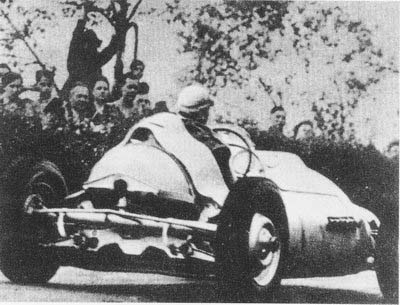
Pietsch wins the 1951 Eifelrennen with what had not fallen off from his Veritas Meteor...
1951, Pt. V
In spite of the lack of works engagement 1951 would see the first (and single) great Veritas success in Formula 2, at the Eifelrennen.
Luckily for Pietsch the announced Scuderia Ferrari entries of Ascari and Villoresi turned out to be a promotion gag by the organisers, so he mainly had to face local opposition, with only some private foreign participants. Already on the first lap Pietsch took over the lead, much cheered by the crowd. Only after the race Pietsch learned that the excitement of the spectators was mainly due to the fact that the rear bodywork of his car had fallen off as early as on the first lap of the race! But despite also suffering from gearbox problems near the end of the race he remained firmly in the lead and won the race well ahead of the AFMs of Rieß and Heeks.
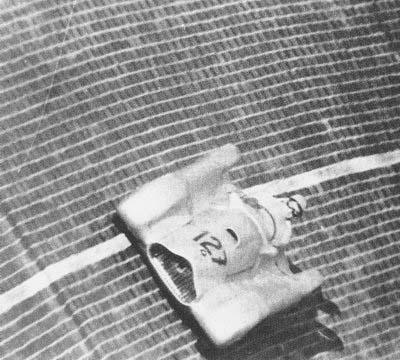
Special streamlined bodywork variants were popular on high-speed circuits like Avus or the Grenzlandring. This one is Pietsch's Veritas Meteor of 1951 with added side-pods to cover the wheels and suspension parts.
1951, Pt. VI
The next race on the calendar was the revival of the Avusrennen at Berlin, which had been so popular in the pre-war era. This high-speed track consisted mainly of two long straights, connected by a sharp hairpin at the South and a high-speed banked curve at the North. Because of these characteristics it had always been popular to use specially streamlined bodyworks in these races, like the Mercedes and Auto Union record breakers of the thirties. So in best AVUS tradition Pietsch fitted his car with this special bodywork after the first practice session, as can be seen on the picture. During the early stages of the race Pietsch managed to stay in contention with the leading group before he had to retire due to a technical failure.
1951 was really a good season for Pietsch as he also scored a victory against Hans Stuck on the Bergmeister's domain, at the Schauinsland, thereby also beating Stirling Moss in the HWM by some 15 seconds! As this race also counted towards the German championship Pietsch was now in a very comfortable lead, so that his fifth place at the Grenzlandring was sufficient for him to secure the 1951 title.
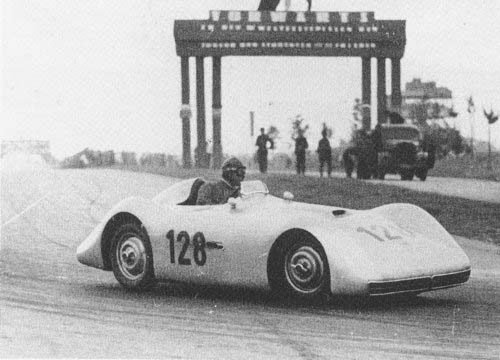
Hans Klenk in his Veritas Meteor at Dresden-Hellerau, East Germany, in 1951.
1951, Pt. VII
Besides Pietsch there was only one other regular Meteor driver in 1951. Karl Kling became more and more involved in the revival of Mercedes racing activities, so he sold his streamliner to newcomer Hans Klenk from Stuttgart. Klenk, in his very first race, finished an impressive fifth at the Eifelrennen, and then entered his car for the East German race at Dresden-Hellerau, where he scored an unchallenged victory against the best what the East Germans could field against him.
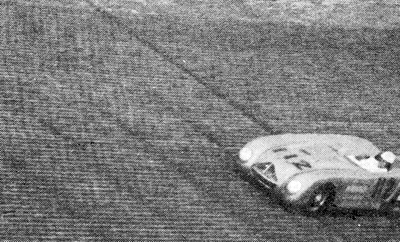
Ulmen takes the famous banked Nordkurve in his quick Veritas RS "bathtub" at the Avus race of 1951.
1951, Pt. VIII
With victories at Hockenheim, the Schauinsland hillclimb and the Grenzlandring Ulmen was clear champion in the 2-litre sports car class. (Interestingly, he seems to have frequently used a standard pontoon-shaped RS sports car as well in that year's Formula 2 events rather than his special open-wheeled variant.)
But while Veritas were still overwhelmingly superior in big sports cars, the marque was beginning to lose contention in the 1.5-litre class, where competition became tougher, and they could not score a single victory. Consequently the title fell to Walter Glöckler, driving a car of Germany's upcoming sports car marque, Porsche.
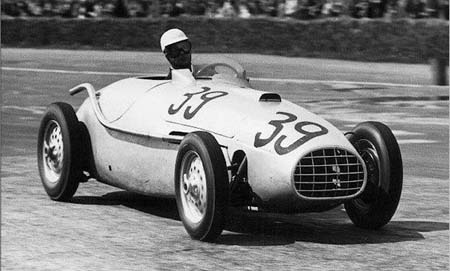
Ulmen's Veritas "Grandma" as a Formula 2 car at Silverstone in 1952.
1952, Pt. I
As mentioned earlier Ulmen also used a third Veritas variant, not only in Formula 2 races, but also in some sportscar events. The origins of that car seem to be still mysterious, as it is not quite clear whether it was a second rebuild of his special single seater from 1950 or simply converted from yet another RS sports car. The fact that the car, which still survives today, is known as the Großmutter (which means "Grandma") might indicate, that it is based on the original prototype, which Meier had used during the 1948 season. At least it is confirmed that Ulmen was in possession of that car's very special triple-camshaft BMW engine.
Be it as it is, the car was yet another effort to avoid the disadvantages of the Aerosaur RS sports car's unwieldy bodywork on twisted circuits. The offset-seated layout was very popular among German special builders of that time, being a good compromise, as with its detachable lights and wings these cars could easily be turned from a sports car into a Formula 2 machine. To express their intermediate character such cars were called "intertypes" in Germany and they were a very familiar view on the race tracks all through that period.
Ulmen used this car when he took part in the 1952 International Trophy at Silverstone, which he finished after a steady drive to 11th position. The picture makes it clear that the little car must have been really much more driveable than the standard RS.
In 1952 the world championship was run according to Formula 2 rules, which meant that all the internationally established race car manufacturers, like Ferrari, Maserati, Gordini, Cooper or HWM fully concentrated on the development of their new cars. Of course this had the effect that German amateur efforts like Ulmen's, based on designs which were already at least two or more years old, had become virtually chanceless now.
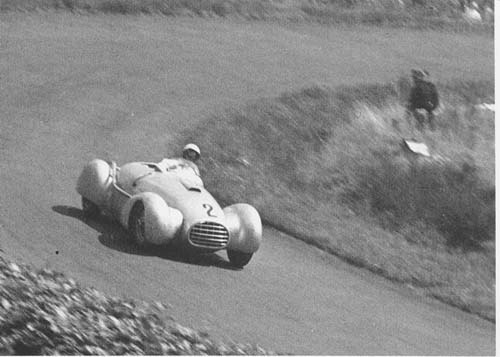
The Grandma again, this time in sports car disguise, at the Nürburgring in 1952.
1952, Pt. II
Consequently Ulmen's fortunes lay in the sports car class rather than in Formula 2 races, so for the German Grand Prix the car appeared with its wings attached. In the race Ulmen was challenged only initially by Adolff's conventional Veritas RS, but after the Aerosaur's engine failure nobody was left to prevent Ulmen from victory.
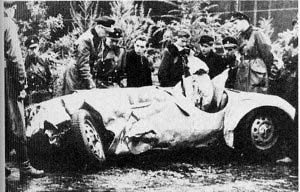
This is what remained of the Grandma after Ulmen's crash at the Sachsenring in 1952.
1952, Pt. III
After the German Grand Prix Ulmen took his car to East Germany for the race at the Sachsenring near Hohenstein-Ernstthal. During practice he had a big accident, which left the car in a quite bad condition, as can be seen on the picture. Ulmen sold the wreck to Hans Klenk, who had it repaired and entered it on some occasions in 1953 for his talented protégées Hans Herrmann and Ernst Lautenschlager (see later).
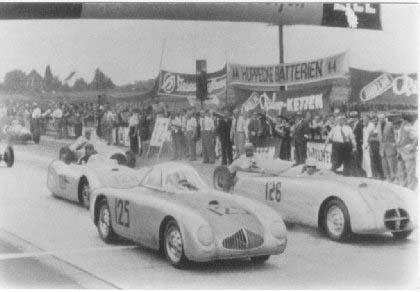
Experimenting with aerodynamics at high-speed circuits: Ulmen's fully enclosed Veritas RS (125) at the start of the 1952 race at the Grenzlandring. Alongside him Kurt Adolff (126) in Franz Rissmann's Veritas. The car behind Klenk is an AFM, the rest is still unidentified.
1952, Pt. IV
Ulmen could easily abandon his open-wheeler as the 1952 season finished with the two races at the Grenzlandring and AVUS. In such high-speed events his streamliner seemed to be the better choice in any case. Always being very innovative, Ulmen brought yet another Veritas variant to the fast circuit near the Dutch border. In order to reach aerodynamic perfection he even fitted the cockpit of his RS sports car with a Lucite hood. With this configuration Ulmen won the race and also scored fastest lap, but it may be regarded as a good indication of the state of German Formula 2 racing, that he did not reach the lap times Stuck had set in his AFM-Küchen the year before.
After his earlier 1952 successes Ulmen came to the final event of the season, the Avusrennen, as championship leader in the 2-litre sports cars as well as in Formula 2 class. There, in a dramatic slipstream battle, Rieß (in another Veritas RS) finally snatched a victory from Ulmen after taking the lead on the penultimate lap. With this victory both drivers were equal on points, and according to the regulations Rieß was declared as champion as he had scored the better result at the Eifelrennen.
As a consolation Ulmen was awarded the Formula 2 title, even if he could not take part in this race, after the engine of his car, again with the cockpit hood, did not run properly during practice. But his points advantage had been already sufficient enough to secure the championship from Rieß, who arrived in third place at the finish.
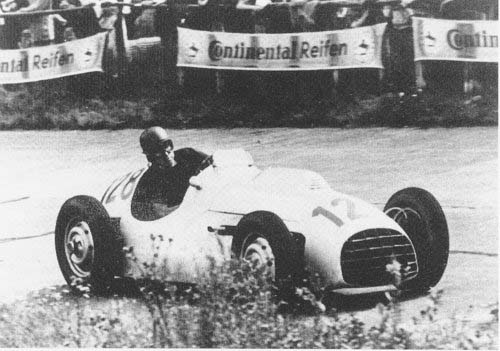
Hans Klenk in his completely rebuilt Veritas Meteor at the 1952 German Grand Prix.
1952, Pt. V
Like Ulmen, Hans Klenk had recognized the disadvantages of a streamlined bodywork on such demanding circuits as the Nürburgring. The result can be seen on the picture, which was taken during the German Grand Prix, Klenk having the car completely rebodied. In the race he was lucky to avoid Bonetto's Maserati in the initial stages, after which he performed a steady mid-field drive until he had to drop back due to technical problems.
Of course for the faster circuits he still preferred the full-enveloping bodywork and in this configuration he finished second to Ulmen at the Grenzlandring and again second, behind Fischer's impressive Ferrari 500 at Avus.
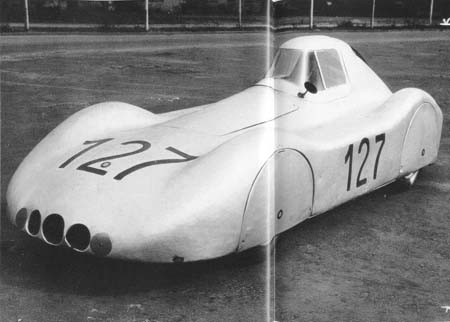
Streamline in extreme form: Pietsch's 1952 Avus Special.
1952, Pt. VI
This car is another very interesting Veritas development. Paul Pietsch, who still was one of the marque's most faithful customers, had ordered this special bodywork at the factory for the high-speed Avusrennen. It is noticeable that not only the cockpit was fully enclosed, but also the wheels were totally covered. To allow for steering the wheel covers in the front had to be attached with springs. This allowed a steering angle only just sufficient to take the hairpin, so the car was a true AVUS Special, surely not suitable on any other kind of racetrack.
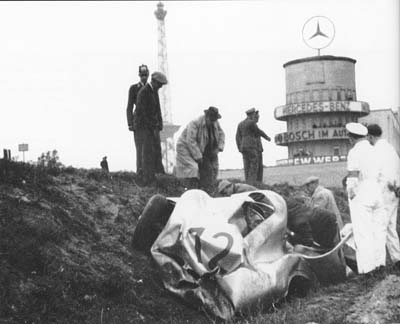
The remains of Pietsch's AVUS Special after his accident in the Nordkurve.
1952, Pt. VII
During practice the car proved to be nearly on terms with Fischer's powerful new Ferrari 500, but on the second day Pietsch suffered a dreadful accident when he lost control on a bump in the banked Nordkurve. The car shot into the infield and overturned three times before coming to a rest. Pietsch was lucky to survive, but his injuries were severe enough that he began thinking about retirement.
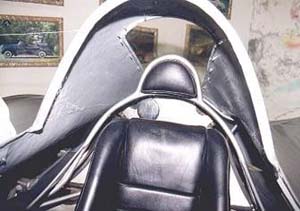
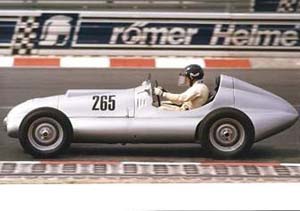
The restored Avus Special today. The left picture shows how the second shell is put over the original bodywork, so the car can be easily turn into an open-wheeler again.
Two pictures that show the beautifully restored car in today's shape. On the first picture you can clearly see how the enveloping panels cover the original bodywork beneath! The second picture shows the car as an open-wheeler. So if you intend buy the car at the Sinsheim auction, you would really get your money's worth - two cars in one!
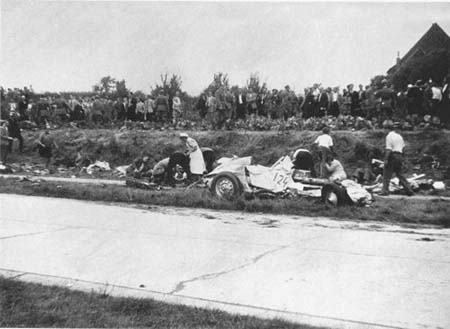
The most dreadful moment in German motorracing so far: Niedermayr's crashing car killing 14 people in the crash at the Grenzlandring. [1] is sure about this car being Niedermayr's Veritas Meteor, as it is reported that the AFM already was put aside with technical problems the day before. But the front wheel caps look quite AFM-style!
1952, Pt. VII
Having already told you about various accidents I would leave the Veritas history incomplete when forgetting about the blackest moment of all of Germany's motor racing history.
It happened at the Grenzlandring, when Helmut Niedermayr in his Meteor left the track at the Roermond bend, getting onto the infield, where the spectators had gathered, as this had been regarded as a safe place. Nine people were instantly killed, five more died during the next few days, and altogether 26 suffered from more or less severe wounds. Niedermayr himself was lucky to survive with only mediocre injuries.
After Gommann's crash in 1950 this was the second dreadful accident here and of course this also meant the end of what had been regarded as Germany's fastest race track.
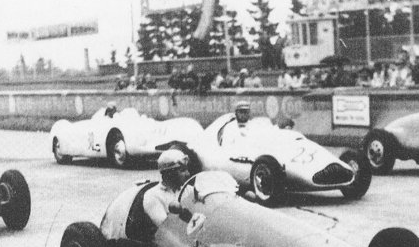
A practice shot of the 1953 German Grand Prix. Car No.23 is Heeks new (?) Meteor, while No.30 at the back of the grid is Loof himself in the last car of the Meteor series.
1953, Pt. I
In 1953 the Veritas company made its final effort to officially return to the racing business. Willi Heeks and Kurt Adolff, already Veritas customers, formed a new race team, the works-supported Renngemeinschaft Nürburgring, for which Loof reportedly built two completely new Formula 2 and also a 1.5-litre sports car.
Because of the international superiority in this category there remained just a few Formula 2 events in West Germany, but all the locals still gathered for the most important local event of the season, the German Grand Prix. Adolff was lucky to be offered a drive in Fischer's Tipo 500 Ferrari so in this race Loof finally took the chance to represent Veritas colours himself. The car he used (No.30 on the picture) was a streamliner with an offset driver position, which is very suspiciously alike to the car in the following picture. So maybe it would be more correct to classify it as a contemporary Veritas-Nürburgring RS sports car model, which now of course were powered by Meteor engines instead of the ancient BMW.
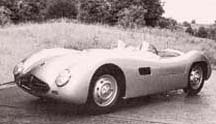
Veritas-Nürburgring RS, 1952/'53.
Symptomatically Loof's car was the first to drop out of the race after an early fuel pump failure, while Heeks (car No.23) lasted for eight laps in the midfield.
Shortly afterwards the Veritas company went bankrupt for the second time. The remains were taken over by the BMW company, together with Loof, who had already been employed by them before the war. But by that time he had already fallen ill and died from his disease in 1956.
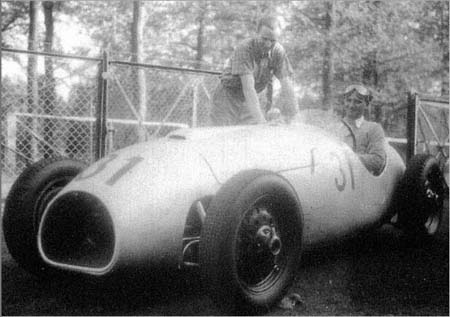
Hans Herrmann proudly sits in the repaired and rebodied ex-Ulmen Großmutter, which Klenk had bought after its crash at the Sachsenring the previous season. The picture was taken at the Nürburgring, probably at the Eifelrennen.
1953, Pt. II
In the 1952 section of this article you read about Ulmen's destroyed Veritas Großmutter (after its Sachsenring crash). The wreck was bought and built up again by Klenk. The result can be seen on this picture, when young Hans Herrmann, the new German star on the horizon, posed proudly in the cockpit of his first Formula 2 car at the 1953 Eifelrennen.
In spite of a retirement here, he was allowed to take part in the Avus race as a member of Klenk's Formula 2 team. Besides Klenk and Herrmann, yet another newcomer, Ernst Lautenschlager, was part of the team. Herrmann finished fourth, Lautenschlager eighth while their team leader/owner scored a nice second as best-placed German in his streamlined Meteor.
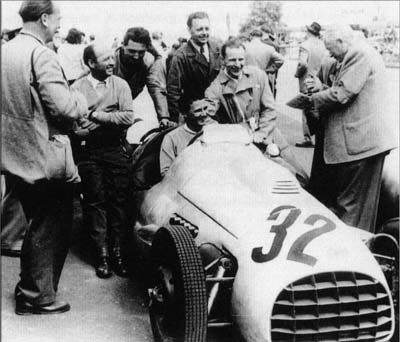
Hans Herrmann in the completely overworked Klenk Meteor during the Grand Prix event at the Nürburgring in 1953.
1953, Pt. III
There is some confusion about which member of Klenk's team raced in which car in 1953, especially at the following German Grand Prix, where Klenk could not take part himself, as he had suffered some severe injuries in a test session for Mercedes-Benz in their 300SL sportscar, which put an end to his career as a driver.
So it seems that Herrmann was given the drive in Klenk's Meteor, while some sources also mention Erwin Bauer. But there are some pictures on which Herrmann can be seen in the cockpit, and so it seems more likely to me that Bauer started in the Großmutter.
The team had a third car, the BMW-based Eigenbau of Willi Krakau, in which Lautenschlager is reported to have started earlier in that season, but it seems that neither he nor the car have been taken to the 'Ring for the Grand Prix.
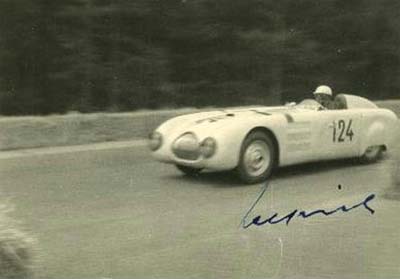
Helfrich's Veritas RS in an East German race, probably in 1953 at the Sachsenring.
1953, Pt. IV
With the Veritas story nearing its end the few remaining customers had to look for some niches where they could still have hope for some success by avoiding the strong international competition. Some of them found such a hidden reservate in the East German races, where Formula 2 was still alive, with no danger of facing foreign cars or drivers.
At that time the border was still relatively open as the East German government propagated a neutralized and united Germany. Therefore West German entries were rather welcome as they could be used propaganda-wise as a proof of the verbindende Sportkameradschaft ("connecting sports comradeship") between Germany's two parts and to demonstrate superiority of socialism, as long as they would not turn into a real challenge of the EMW works cars, which officially represented the East German state.
One of the most common participants in these races was Theo Helfrich from Mannheim with his faithful Veritas RS sports car. On pictures he can easily be recognised by the familiar colour scheme of his car, some bright paint (white?) with a dark ribbon around the bonnet and dark covers for the lights.
The picture shows him taking part in one of these races, perhaps at the 1953 Sachsenringrennen. But it is also possible that it was even taken as late as in 1954, when the old Formula 2 was still running there, even if it did not exist any longer internationally.
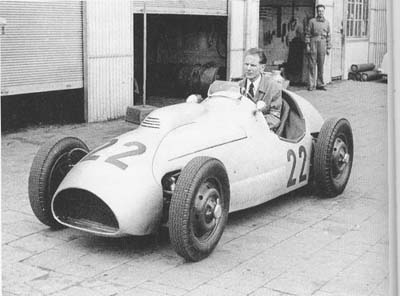
Veritas swansong: Mechanic Heinz Jacht in Klenk's Meteor during the Grand Prix weekend at the Nürburgring in 1954.
1954, Pt I
But the Veritas story is not over yet. Klenk had overworked his Meteor once again and entered it for the German Grand Prix, giving away some 500cc of engine capacity to the limits of the new Formula 1 rules.
The picture shows the car with Klenk's mechanic, Heinz Jacht, behind the wheel. In the race it was driven by Theo Helfrich, who naturally stood no chance against the works teams of Ferrari, Maserati and, of course, Mercedes and had to retire after eight laps at the rear of the field.
The tide had completely turned…
Veritas chassis list
Just to separate the cars from each other my own unofficial numbering system is applied. Cars with confirmed identity are marked by a "#".
# BMW 328 Mille Miglia
- streamlined coupé version of the standard BMW 328, designed by Dr. Kamm
- built for the 1940 Targa Florio (Lurani / Cortese; retired)
- owned by Loof post-war
- raced by Hermann Lang (Ruhestein 1946) and Karl Kling (Hockenheim 1947)
Veritas RS prototype
BMW-Veritas / Veritas RS series
It is hard to identify single cars as quite a lot were built and some of them were never raced but used as road-going sports cars. 11 cars were built in the initial production series [5], but I do not know whether these include Kling's two self-built versions.
| #K1 | 1947 | Kling |
|
| #K2 | 1948 | Kling |
|
| #1 | 1948 | works car |
|
| #2 | 1948 | Ulmen |
|
| #3 | 1948 | Roese |
|
| #4 | 1948 | Schäufele |
|
| #5 | 1948 | ? |
|
| GM | 1951? | Ulmen |
|
| US | 1950 | Ulmen |
|
Veritas Monoposto
| #1 | 1948 | ? |
|
| #1 | 1949 | works car |
|
| #2 | 1950 | Ecurie Suisse |
|
| #3 | 1950 | Ecurie Suisse |
|
| #4 | 1950 | Ecurie Suisse |
|
| #5 | 1950 | Kling |
|
| #6 | 1950 | Pietsch |
|
| #7 | 1951 | Rissmann |
|
| 8 | 1951 | Niedermayr |
|
| 9? | 1951 | Legat |
|
| 10? | 1951? | Vermeulen |
|
| 11? | 1953 | RG Nürburgring |
|
| #12 | 1953 | RG Nürburgring |
|
Picture sources
- Reinald Schumann: Motorsport in Deutschland 1945-1955
- Copies of old race reports, like issues of Das Auto, but some of them also unknown to me
- Ingo Seiff: Der Schottenring
- Website of Joachim Traber
- Official Website of the new Veritas company
- Riedner: Doppelsieg (Pietsch Biography)
- Eberhard Reuß: Grand Prix
- Walter Zeichner: Kleinwagen International
- Werner Oswald: Deutsche Autos seit 1945
- Website of the Auto-Salon Singen auction
- Website of Prova, Magazin für Automobile Avantgarde
Feedback
The author appreciates receiving feedback and/or any information to improve his article. You can reach him at uechtel@gmx.de.
